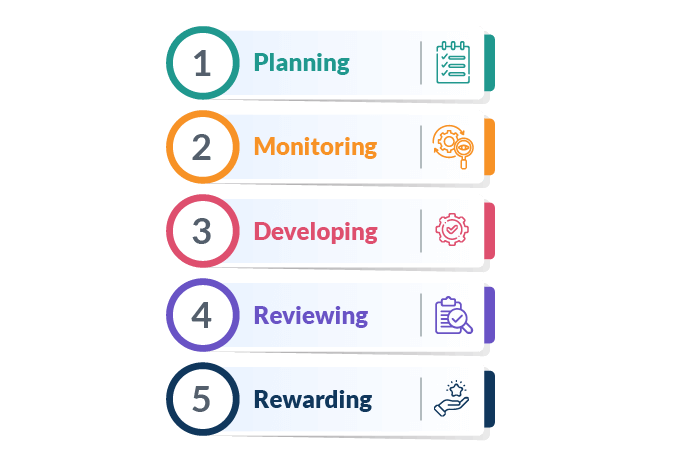Performance Management: Everything You Need To Know
Effective performance management is the key to unlocking an organization's full potential. Companies can accelerate growth and outperform competitors by aligning, developing, and motivating the workforce. Yet performance management remains an elusive beast for many organizations.
Unfortunately, the term "performance management" is used widely without understanding its true meaning. A leader must recognize and value its role in increasing employee job satisfaction levels and improving the organization's bottom line.
Let's unravel the concept of performance management in organizations and how it can transform employee and company performance.
Key Insights
- Concept of Performance Management and Its Importance
- Process of Performance Management
- Examples of Performance Management
- Performance Management Best Practices
- Challenges of a Performance Management System
What is Performance Management?

Performance management can be defined as a process that continuously identifies, measures, and develops the performance of the workforce in the organization.
It does so by setting goals, monitoring progress, and providing ongoing feedback to help employees improve and excel in their roles.
Performance management ensures employees are aligned with the organization's goals and objectives and equipped with the skills needed to achieve them.
Companies can simplify goals with the help of performance management software, accelerate performance reviews, and improve the performance appraisal process while giving some power back to the employees.
But, an effective performance management process is more than just about setting goals. The ultimate goal of it is to improve the quality of work. For it to work, it is important to understand its key elements:
- Goal setting
- Regular Check-ins
- Feedback
- Development
- Evaluation
- Rewards
However, before we delve into these elements, let's get our basics straight first. and understand the importance of performance management.
Why is Performance Management Important?

Performance management is essential for every organization. It allows companies to get the best out of their employees and align them to business objectives. Without effective performance management, organizations miss out on the full potential of their human capital.
As per a study in 2022, around 98% of American organizations consider performance management crucial for the workplace.
There are several key reasons why performance management is crucial:
Drives Business Results
At its essence, performance management is the engine that powers organizations to accomplish their business objectives. It accomplishes this by ensuring that employees comprehend their roles and possess the essential skills to execute business strategies effectively. When implemented skillfully, performance management becomes the driving force, empowering organizations to hit targets and outperform the competition.
Develops Employees
At its core, performance management is a continuous feedback process that shines a light on opportunities for learning and growth. This ongoing dialogue nurtures the growth of employees, enabling them to develop new skills and competencies.
A study shows that 80% of employees would rather have immediate feedback than an annual performance review.
As a result, a robust performance management system not only hones existing talent but also creates a steady pipeline of future leaders ready to steer the organization forward.
Boosts Engagement
Performance management creates an environment of engagement by fostering ongoing conversations and providing crystal-clear clarity regarding individual and team goals. Employees who receive constructive feedback feel valued, knowing that their contributions matter. This heightened sense of purpose, coupled with the knowledge that managers are invested in their progress, motivates employees to put forth maximum effort.
Retains Top Talent
Performance management is integral for retaining top talent. When high-performing employees feel adequately supported and can visualize a clear career path within the organization, their commitment to staying and contributing grows stronger. Performance management provides this roadmap, offering assurance and guidance instead of leaving employees in the dark about their future prospects.
Identifies Problems
Regular performance check-ins serve as early warning signals for potential challenges before they snowball into major issues. By maintaining a pulse on employee performance, managers can swiftly identify areas where individuals may be struggling and step in with guidance and support to set things back on the right course.
Promotes Transparency
Open and frequent dialogue forms the cornerstone of performance management, fostering trust between employees and managers. This transparent communication ensures that both parties fully grasp expectations, and it creates a safe space for open, honest feedback. This level of transparency serves as the bedrock upon which effective performance management is built.
Differentiates Performance
Performance management supplies an objective perspective for evaluating and differentiating employee contributions. Measurable goals and Key Performance Indicators (KPIs) provide a clear, unbiased view of individual performance in comparison to peers. Armed with this data, organizations can make informed decisions regarding promotions and rewards, ensuring fairness and equity in their workforce management practices.
Performance Management Process

The performance management process generally follows a cycle with the following key stages:
Planning
At the initial planning stage, a collaborative effort between managers and employees takes center stage. This involves setting clear expectations and well-defined goals that align seamlessly with the broader organizational objectives.
Key elements encompass outlining success metrics, defining job responsibilities, and crafting personal development plans tailored to each employee's growth trajectory.
Monitoring
As the performance period unfolds, the monitoring stage assumes a pivotal role. Managers take on the responsibility of regularly checking in on progress and offering constructive feedback. This continuous attentiveness ensures that performance is consistently tracked, allowing for the timely identification of achievements and areas for improvement. How is it done? Through feedback, surveys, and fortnightly town hall meetings.
This stage serves as a compass, guiding both employees and managers toward their shared performance goals.
Developing
As the monitoring stage identifies areas for improvement, the next stage emphasizes further growth and development. The developing stage focuses on opportunities for training, coaching, or other development activities to enhance employees' skills and abilities.
When issues arise, whether minor or significant, they are addressed promptly through corrective actions such as counseling, written warnings, performance improvement plans, etc. This stage is instrumental in reinforcing the commitment to individual growth.
Reviewing
Upon reaching the conclusion of the performance cycle, managers initiate the reviewing stage. This stage involves a comprehensive appraisal meeting where results are rigorously assessed against the initial goals and expectations.
Through constructive feedback, the managers thoughtfully highlight achievements and identify opportunities for improvement. This stage acts as a mirror, encouraging employees to recognize their strengths and acknowledge areas that require refinement.
Rewarding
The final stage of the performance management process is the rewarding stage, which ties it together. Here, the link between exceptional performance and appropriate rewards is established. Whether it be salary increases, bonuses, promotions, or other forms of recognition, strong performance is acknowledged and rewarded.
This stage not only validates employees' hard work and dedication but also serves as a powerful motivator for future endeavors.
Real-World Performance Management Examples
1: Goal management

To achieve results and improve performance, employees need to have well-defined SMART goals. With clear goals, workers know exactly what they need to do and get more satisfaction from their work.
In many companies, goal setting happens only once per year. When the year ends, these companies revisit the goals they set a year ago. But often, those goals are no longer relevant.
According to Deloitte, companies that look at goals every quarter see 30% greater performance and retention than companies that look at goals yearly.
Your performance management system needs to help users manage their work objectives continuously. Employees should be able to set weekly, monthly, and quarterly goals. They also should be able to share their goals with managers and track individual progress.
2: OKR Management Methodology

John Doerr originally presented OKRs to Google’s leadership in 1999 when Google was less than a year old. And they’ve been in use ever since.
The idea of OKR, which stands for Objective Key Results, is to connect employees' work to the company's strategic goals.
The objective is an ambitious goal that an entire organization wants to accomplish. Key Results are measurable tasks or milestones that define how a given employee can help to achieve their objectives.
Here are a few keys to what makes OKRs work at Google:
- Objectives are ambitious and should feel somewhat challenging.
- Key Results are measurable. They should be easy to grade with a number.
- OKRs are public. Everyone on the team should see what everyone else is working on and how they did in the past.
3: Recognition

Recognition features are very important for a performance management system. Appreciating employees motivates them, increases their productivity, and boosts self-confidence. As a result, most existing performance management systems include recognition functionality.
It provides you with the flexibility to incorporate a system that will help in elevating individual performance. And not only that, recognition plays a pivotal role in the workforce's overall performance. It improves the organization's bottom line in the long term.
To further help you with that, Vantage Circle’s one-stop solution provides companies with the necessary platform to reward, recognize, and appreciate the employees’ dedication and effort. To know our innovative features for Rewarding and recognizing, visit our website or Book a demo now.
4: One-on-One Meetings

One of the most under-appreciated tools of any manager's toolkit is that of the one-on-one meeting.
It's time you take time to connect with each employee in your team, get a sense of what they're working on, where their priorities are, any obstacles that are in their way, share information they need to know, and develop a relationship with them grounded in trust.
Here are some tips for running productive one-on-one meetings:
- To begin with, be consistent and regular with these meetings.
- One-on-one meetings are a two-way street. Listen to what your employees have to say. Try not to superimpose.
- See a one-on-one meeting as a bonding opportunity.
- Mainly, keep track of what you discuss.
- Regularly discuss future expectations.
5: 360 Degree Feedback

360-degree reviews let employees receive feedback from their peers. In small improvements, employees can indicate who they want to be reviewed by. A reviewer then gets a notification to their email with a link to the review.
Reviewers answer questions and can view historical feedback about the employees. This feedback puts the review in context and includes records of one-on-one conversations, praises, check-ins, and feedback forms. It helps managers complete a correct annual performance review of the employees without leaving any loopholes.
6: Ease Of Use

Your performance management solution needs to offer a simple user interface. Also, has to integrate with tools that employees use every day, such as Slack, Gmail, and Outlook.
Your performance management app needs to be more employee-focused. And because the majority of your users will most likely be millennials. Thus, it needs to appeal to their preferences and needs.
7: Continuous Feedback

Continuous feedback is an essential pillar of modern performance management systems. It should be performance-based that will help you measure individual employees’ skills and abilities.
Providing feedback is critical to engagement and retention. But to be effective, feedback needs to be regular and on the spot. Millennials want immediate recognition of their efforts. And they value feedback not only from their managers but also from their peers.
Best Practices for Performance Management Process

Here are some best practices for developing and administering an effective Performance Management Process:
Set Priorities
An organization should practice aligning employee’s individual goals with the top 2-3 organizational priorities. This alignment keeps the spotlight firmly fixed on objectives that hold the utmost significance for the business. Regular quarterly reviews of these priorities facilitate goal adjustments that maintain relevance and alignment.
Develop Skill and Competency Frameworks
Developing skill and competency frameworks is a strategic approach to guide performance management. These frameworks outline the specific skills, knowledge, and behaviors required for success in various organizational roles. Organizations can effectively assess and develop their employees by defining these essential competencies.
Examples of some Skill and Competency Frameworks are -
- The SHRM Competency Model, developed by the Society for Human Resource Management (SHRM), outlines the competencies needed for HR professionals at different career stages.
- The Skills Framework for the Information Age (SFIA) is widely used in the IT industry and defines skills and competencies related to information and communications technology (ICT).
- Leadership Competency Framework can be developed by any organization and tailored to their specific leadership needs and organizational culture. These frameworks define the skills and behaviors required for effective leadership within the company.
- The Universal Competency Framework is a general framework that outlines core competencies applicable to a wide range of roles and industries. It includes competencies like communication, teamwork, problem-solving, and adaptability.
Conduct Regular Pulse Surveys
Organizations often use regular pulse surveys to gain insights into employee engagement, satisfaction, and well-being. These surveys are typically short, frequent questionnaires that employees complete to provide feedback on their workplace experiences. Pulse survey questions should be eNPS-based for better accuracy and acceptance.
The data collected helps organizations gauge overall employee sentiment and identify areas that require attention. For example, if pulse survey results indicate declining morale within a specific department, the organization can proactively address concerns and improve the work environment.
Invest in Manager Training and Support
Investing in manager training and support is essential for effective performance management. Managers play a pivotal role in the process, from conducting performance discussions to delivering feedback and coaching employees for improvement.
Providing managers with training in these areas equips them with the skills needed to engage in constructive dialogue. Additionally, ongoing support, such as mentoring and access to resources, ensures that managers can effectively navigate the complexities of performance management.
Leverage Technology
Incorporating technology into performance management processes is a strategic requirement in the modern workplace. Performance management software tools streamline administrative tasks and empower organizations with data-driven insights, offering comprehensive analytics dashboards for trend analysis and resource allocation.
Additionally, technology-driven performance management -
- Supports constructive dialogue,
- Benefits employees and organizations alike,
- Enhances employee engagement by providing platforms for goal tracking, feedback, and development planning,
- Ensures transparency, accessibility, and robust documentation for compliance.
Challenges Faced While Implementing a Performance Management System

Facilitating a good performance management software will require you to understand the dynamics of how it works. You need to keep various factors in mind before making room for it in your internal system. Below is a list of four crucial components that one has to consider before implementing a performance management system.
1. The Design
One of the most crucial aspects of implementing these systems is that it needs to be aligned with the organization’s needs and requirements. Therefore, choosing the right and appropriate tool will prove vital for the organization’s long-term success.
Human resource managers make a common mistake because even if they are compatible with the organization, they negate how it will inflict them. Instead, employees should understand how the system is going to elevate their performance.
Another thing to keep in mind before choosing any tool should be the user interface and gamification levels it can provide. It should not become monotonous over time. The system should be tangible, robust, flexible, and sustainable to help the organization in the long run.
2. Budget of The Organization
The budget is something that every manager should consider before opting for a tool. You will find numerous tools in the market that will provide you with all the necessities. However, the tools you think might be out of your budget and can offer a significant roadblock in implementing a system you want.
It is essential to scrutinize the system and align it with the employees' needs. Ensure that there are no significant drawbacks and you opt for the desired tool that fits the organization.
3. Managing the System
One of the hardest things to do after implementing a performance management system is managing the system to keep it afloat and running smoothly. It requires a disciplined approach and a proper framework that will help the organization. Furthermore, the system should be flexible to be changed efficiently according to the rising needs with modernization.
It is a continuous process that revolves around appraisals, feedback, and employee development. This makes it crucial to manage the system daily to never lack an environment where employees can thrive.
4. A System That Elevates Performance
The crucial factor of a performance management system is its ability to distinguish poor employee performance and the best ways to boost employee performance. It needs to figure out the individual strengths and weaknesses to understand their overall competency levels. The ultimate objective of a performance management system is to help employees to develop their skills and abilities to enhance performance.
However, it is quite challenging to have a system that will do all that for you and the organization. The perfect solution will be hard to find. Still, it is essential to have a system that will provide you with the necessary performance management needs and enhance work efficiency.
Recommended: Employee Performance Tracking: Importance And Ways To Do It
To Conclude
In brief, effective implementation of a performance management system can propel your organization to new heights. It can help you facilitate high performing teams that are capable of achieving the goals and objectives. Thus treat the above point as a checklist to build a more productive workforce.


















